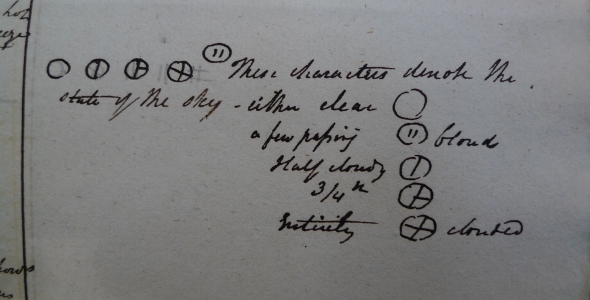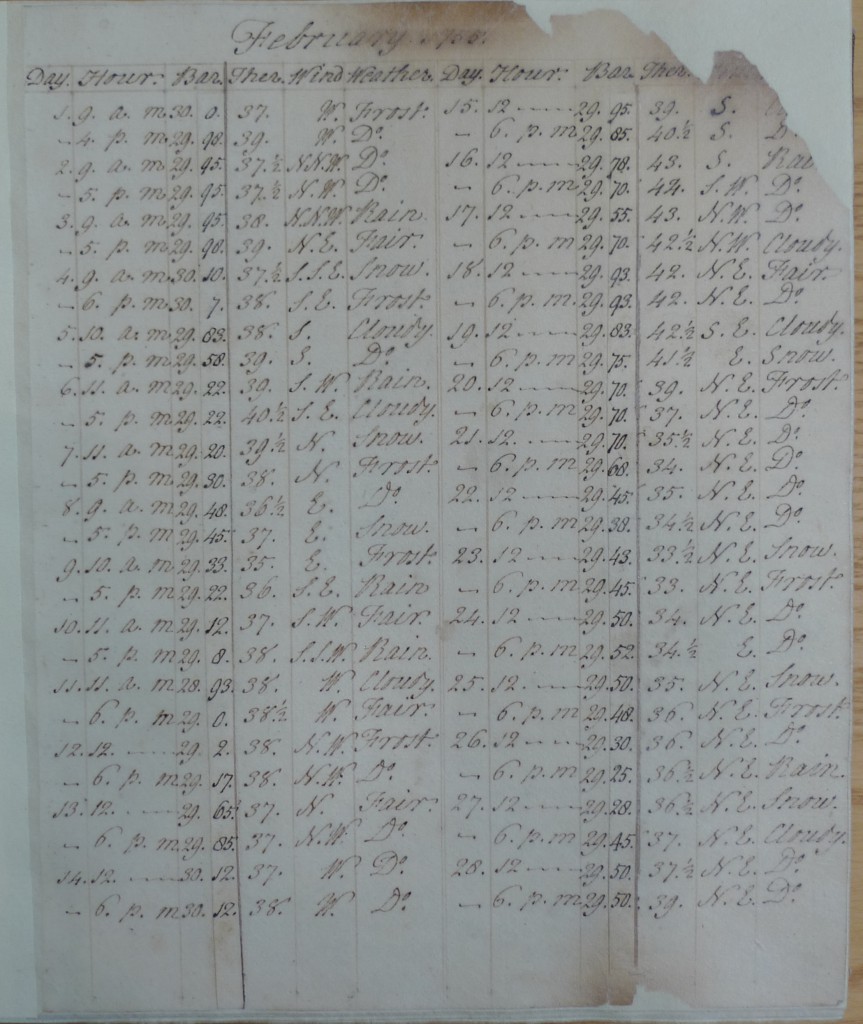
May 16, 2014, by simon.naylor
Getting into the archive: Eighteenth-century weather diaries in Devon
Devon Heritage Centre and the National Meteorological Archive
The Devon Heritage Centre is housed in an unprepossessing building amidst a jumble of light industrial units, car parks, supermarkets and arterial roads on the edge of the city of Exeter in Devon. It holds archival and local study material relating to that county. Contained within the Centre is the National Meteorological Archive, which is there because the Met Office itself is only 10 minutes away, on the other side of the Honiton Road. The National Meteorological Archive holds probably the most comprehensive collection on the history of meteorology in Britain, ranging from rare books on weather and climate, private weather diaries, daily weather reports, weather charts, and marine weather logbooks. The archive will be central to our investigation of the historical geographies of extreme weather in Britain. The resources at the Devon Heritage Centre will be invaluable too. One of the case-study regions for our project is the southwest of England and the Centre holds a large collection of archival material relevant to the history of the weather in Devon, alongside material held in the North Devon Record Office in Barnstable and the Plymouth and West Devon Record Office. Here are just a few initial thoughts on some of the materials we inspected on a recent visit to the Devon Heritage Centre and the National Meteorological Archive.
Devon weather observers
The weather of Devon was the subject of a number of studies as far back as the mid-eighteenth century. These were usually in the form of diaries, which either gave all of their attention to the weather or incorporated meteorological observations into wider accounts of everyday life. The men and women who produced these accounts were involved in a range of occupations, from the church, to banking, the law, tailoring and the dying of clothes. For instance, the Revd Thomas Heberden kept records of temperature and barometric pressure at various locations in Devon from the 1780s until his death in 1843, when his daughter, Elizabeth, took over. Heberden was a careful observer, who took his meteorological readings at 8am and 2pm consistently over the course of his life, and who worried about the positioning of his instruments and their comparability to other records (his diary also contained weather records from Windsor in Berkshire and Pall Mall in London, taken by his father, William). He was certainly interested in extreme weather, as his diary contained a summary of ‘Remarkable degrees of heat & cold’ for each year. The diary of Samuel Milford was similar to Heberden’s in terms of its style and approach. Milford was a banker and Poor Law commissioner in Exeter, who also kept a weather diary from 1755-1775. Unlike Heberden, the times of Milford’s two daily observations varied, and there is some evidence to suggest that the thermometer had an indoor exposure. Milford’s records shed light on extreme weather events as they were experienced in Exeter, even if his notes were brief. The severe storm that was experienced across England on 15 February 1760 was summarized simply as ‘A Great Storm w’th Thunder and Lightning and Hail.’
Mr John Andrews kept a record of the weather at his home in Modbury in south Devon from 1788 to 1822, which was continued by his son until 1868. Like Heberden, Andrews kept daily records of temperature and barometric pressure as well as notes on the weather, where he recorded unusual and extreme events. On 18 December 1788, for instance, he described an especially cold period, where an opening made in the ice on the pond ‘was frozen over again in less than ¼ of an Hour, while I looked at it’ and where the ice ‘was so firm that I walked across the Pond, with the least Probability of it breaking; and I suppose a Horse or Cart might have went on it.’ The manner in which the weather was recorded in these diaries gradually became more formalised, as the Andrews’ records adopted an increasingly familiar tabular style. However, there continued to be room for personal expression and innovation – for instance, in 1831 John Andrews junior developed a series of characters to express concisely the ‘state of the sky’ (feature image). John Andrews senior’s experiment with the ice and his son’s annotations of cloud cover demonstrate that knowing the weather was an active, creative and place-based practice. Indeed, as we progress with the research for this project one of the issues we will pursue is the way in which people studied, categorized and attempted to order the weather, such that its daily patterns and more occasional extremes could be explained and situated.
A fourth diary that covered a similar period to those above was Samuel Pool’s pocket journal of ‘Remarkable Occurrences’, which he kept from 1754 to 1815. Pool was a dyer by trade and also based in Exeter. Pool’s journal captured all of the events in his life that were exceptional or out of the ordinary in some way. They included marriages, deaths, murders, public hangings, political events and issues related to his business. Also included in his journal were a number of accounts of extreme weather, such as heavy falls of snow, storms, hard frosts and floods. The weather was of course closely related to some of the other events Pool documented – floods resulted in death by drowning for instance, while periods of dryness or excessive rain contributed to higher prices for goods. If Pool had access to a barometer or thermometer he did not record instances of its use. While this might render his diary somewhat less useful to those seeking to reconstruct past weather and climate records, his account was very revealing about the relative significance of the weather in eighteenth-century life. The coming of a storm or a devastating flood punctuated Pool’s life in the same way that a marriage or a death did. In other words, the weather helped Samuel Pool to make sense of himself and the course of his life. The place of the weather, especially in its most extreme manifestations, in the lives of the British will be another abiding concern of our project.
No comments yet, fill out a comment to be the first


Leave a Reply